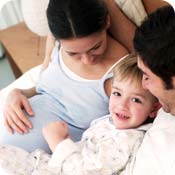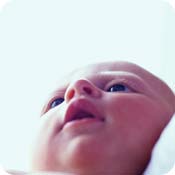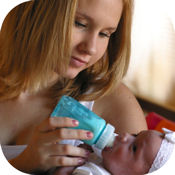 Co-sleeping, or sleeping in the same bed with your child, is a practice that has been used by humans since prehistoric times. Today, co-sleeping is still the norm in most countries around the world. Even in the U.S. (where co-sleeping is the exception to the rule), millions of families share beds with their infants: 13% of infants routinely co-sleep, and nearly 50% co-sleep for at least part of the night.
Co-sleeping, or sleeping in the same bed with your child, is a practice that has been used by humans since prehistoric times. Today, co-sleeping is still the norm in most countries around the world. Even in the U.S. (where co-sleeping is the exception to the rule), millions of families share beds with their infants: 13% of infants routinely co-sleep, and nearly 50% co-sleep for at least part of the night.
Yet recently, co-sleeping has come under fire as a potentially dangerous practice. The controversy stems from a debate on whether or not co-sleeping is safe for babies. As part of new safe-sleeping guidelines issued by the American Academy of Pediatrics (AAP) to help reduce the incidence of SIDS (Sudden Infant Death Syndrome), the AAP issued a recommendation that parents not co-sleep with their infants. The AAP cites numerous studies to support their position that co-sleeping increases the risk of infant death due to suffocation, entrapment, or SIDS. However, many pediatricians and pediatric organizations maintain that co-sleeping can be safe and healthy for infants, children, and their parents, provided a few sensible guidelines are followed (see below). Some of these organizations maintain that co-sleeping is actually safer than crib sleeping. According to Attachment Parenting International (API), "The research has shown that co-sleeping does not increase the risk of SIDS, if practiced following guidelines that create a safe sleeping environment for the child. Further, some research has clearly identified how co-sleeping may reduce infants' risk of SIDS due to the lighter sleep and synchronized parent-infant sleeping patterns associated with this practice." Dr. William Sears, M.D., a renowned pediatrician, author of numerous best-selling books on baby and child care, and creator of the AskDrSears.com website, holds the same opinion. After reviewing numerous studies, Sears states that "infants who sleep in a crib are twice as likely to suffer a sleep-related fatality (including SIDS) as infants who sleep in bed with their parents." According to Sears, "The answer is not to tell parents they shouldn't sleep with their baby, but rather to educate them on how to sleep with their infants safely." Here are some of the recommendations that API and Dr. Sears make to support safe co-sleeping:
While some experts maintain that babies are better off sleeping alone in a crib, other research suggests that the reverse is true. Provided certain guidelines are followed, co-sleeping can actually be a beneficial practice. A 1997 Pediatrics article outlined a study that observed night-time breastfeeding behavior in mother-infant pairs. The study found that co-sleeping led to increased breastfeeding. Because breastfeeding has been shown to have a protective effect against SIDS, then co-sleeping, which facilitates breastfeeding, might be protective against SIDS1. Another article published in Pediatrics suggests that co-sleeping has protective effects against SIDS because of an increase in the infant's arousals and the mother's responsiveness when the pair is co-sleeping2. Some other potential benefits of co-sleeping include:
With so much conflicting information on the subject, the decision about whether or not to co-sleep can be a confusing one for parents and should be discussed with the child's pediatrician. Co-sleeping isn't for everyone; it is not essential for building a healthy relationship with your child, nor is it a guarantee against SIDS. But many families who try it end up loving it so much that they can't imagine it any other way. Sources: (1) McKenna JJ, Mosko SS, Richard CA. Bedsharing promotes breastfeeding. Pediatrics. 1997;100:214-219 (2) Mosko S, Richard C, McKenna J. Infant arousals during mother-infant bed sharing: implications for infant sleep and sudden infant death syndrome research. Pediatrics. 1997;100:841-849 |
Co-Sleeping: Is it Safe?
Learn if Co-Sleeping May be an Option for Your Family
Page 1 of 1






Member Comments